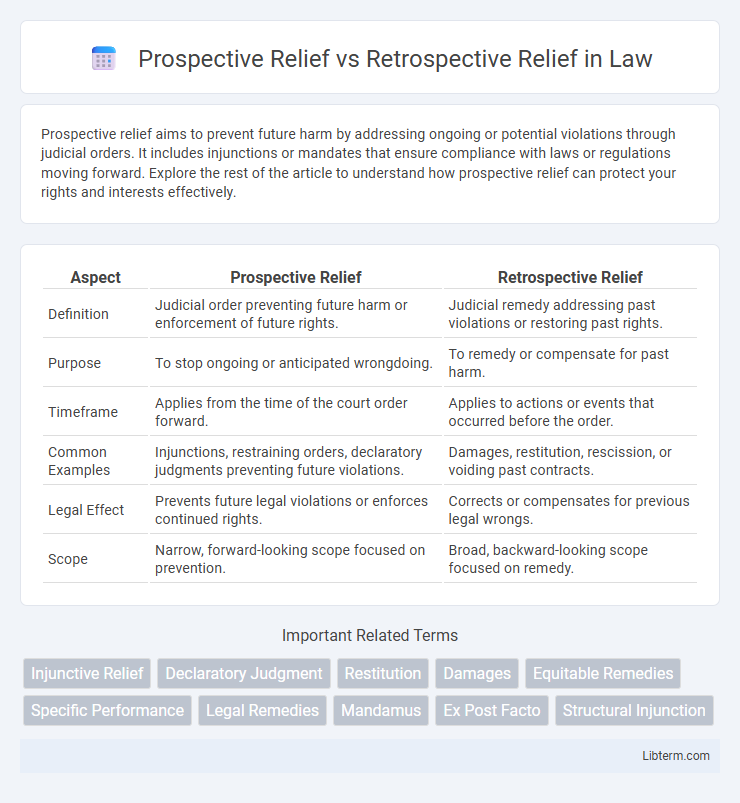Prospective relief aims to prevent future harm by addressing ongoing or potential violations through judicial orders. It includes injunctions or mandates that ensure compliance with laws or regulations moving forward. Explore the rest of the article to understand how prospective relief can protect your rights and interests effectively.
Table of Comparison
| Aspect | Prospective Relief | Retrospective Relief |
|---|---|---|
| Definition | Judicial order preventing future harm or enforcement of future rights. | Judicial remedy addressing past violations or restoring past rights. |
| Purpose | To stop ongoing or anticipated wrongdoing. | To remedy or compensate for past harm. |
| Timeframe | Applies from the time of the court order forward. | Applies to actions or events that occurred before the order. |
| Common Examples | Injunctions, restraining orders, declaratory judgments preventing future violations. | Damages, restitution, rescission, or voiding past contracts. |
| Legal Effect | Prevents future legal violations or enforces continued rights. | Corrects or compensates for previous legal wrongs. |
| Scope | Narrow, forward-looking scope focused on prevention. | Broad, backward-looking scope focused on remedy. |
Introduction to Prospective and Retrospective Relief
Prospective relief involves court-ordered actions designed to prevent ongoing or future violations of legal rights, often enforcing compliance through injunctions or specific performance. Retrospective relief addresses past wrongs by awarding damages or restitution to compensate for harm already suffered. Understanding these distinctions is essential in legal contexts, as prospective relief aims at preventing future injury, while retrospective relief focuses on remedying past damages.
Defining Prospective Relief
Prospective relief refers to a court-ordered remedy that aims to prevent future harm by mandating changes or actions moving forward, rather than addressing past violations. This form of relief typically involves injunctive relief or declaratory judgments that guide future conduct without altering liability for previous events. It contrasts with retrospective relief, which seeks compensation or correction for past injuries or damages already incurred.
Defining Retrospective Relief
Retrospective relief refers to judicial remedies that address past actions or events, often providing compensation or correction for harm already suffered. Unlike prospective relief, which aims to prevent future violations or enforce ongoing compliance, retrospective relief focuses on rectifying or undoing unlawful conduct that has occurred. Courts grant retrospective relief through damages, restitution, or orders that reverse the effects of wrongful acts to restore parties to their prior positions.
Key Differences Between Prospective and Retrospective Relief
Prospective relief refers to court-ordered remedies designed to prevent future violations or harm, typically involving injunctions or orders to change behavior going forward. Retrospective relief, on the other hand, addresses past violations by providing compensation, damages, or restoring rights affected by previous actions. The key difference lies in prospective relief's forward-looking nature aimed at prevention, whereas retrospective relief focuses on remedying and compensating for past wrongs.
Legal Principles Governing Each Type of Relief
Prospective relief aims to prevent future harm by enforcing compliance with legal standards, often through injunctions or declaratory judgments that shape ongoing conduct. Retrospective relief addresses past violations by providing remedies such as damages or restitution, compensating for losses incurred before the court's intervention. Legal principles distinguish these remedies based on their temporal focus: prospective relief emphasizes equitable principles to avoid irreparable harm and maintain status quo, while retrospective relief relies on compensatory doctrines to redress completed wrongs.
Advantages of Prospective Relief
Prospective relief primarily offers the advantage of preventing ongoing or future violations, allowing courts to issue injunctions or orders that ensure compliance moving forward. This form of relief supports regulatory agencies and businesses in maintaining lawful conduct without the disruptions caused by revisiting past actions. By focusing on future compliance, prospective relief reduces the risk of repeated harm, promotes stability, and conserves judicial resources compared to retrospective remedies.
Advantages of Retrospective Relief
Retrospective relief offers the advantage of correcting past legal wrongs by restoring parties to their original position before the infringement occurred, ensuring fair compensation and justice. This type of legal remedy can deter future violations by holding wrongdoers accountable for actions already taken. It provides clarity and finality by addressing and resolving disputes based on historical facts and documented evidence.
Challenges in Granting Each Type of Relief
Prospective relief presents challenges such as ensuring ongoing compliance and monitoring future conduct without unduly restricting lawful activities. Retrospective relief requires accurate reconstruction of past actions and quantifying damages, which can be complicated by incomplete evidence or faded memories. Both types demand meticulous legal scrutiny to balance effective remedies with fairness to the parties involved.
Landmark Cases Illustrating Prospective and Retrospective Relief
Landmark cases such as Chevron U.S.A., Inc. v. Natural Resources Defense Council, Inc. illustrate prospective relief by applying rulings only to future cases, preserving past administrative actions. In contrast, United States v. Swift & Co. exemplifies retrospective relief by invalidating prior conduct and enjoining past violations. These cases delineate the judicial balance between correcting past wrongs and preventing ongoing or future harm under equitable principles.
Conclusion: Choosing the Appropriate Relief in Legal Contexts
Selecting the appropriate relief hinges on the legal issue's nature and the desired outcome. Prospective relief aims to prevent future violations by modifying conduct, ensuring ongoing compliance with legal standards, while retrospective relief addresses past harms, often through damages or restitution. Courts evaluate factors such as fairness, public interest, and the practicality of enforcement to determine whether prospective or retrospective relief best serves justice in each case.
Prospective Relief Infographic

 libterm.com
libterm.com